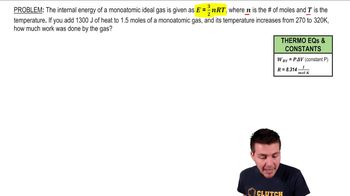Here are the essential concepts you must grasp in order to answer the question correctly.
Work Done on a Gas
In thermodynamics, the work done on a gas during a process can be calculated using the formula W = PΔV, where W is the work, P is the pressure, and ΔV is the change in volume. For processes at constant pressure, this formula simplifies the calculation, allowing us to determine how much energy is transferred to or from the gas as it expands or compresses.
Recommended video:
Calculating Work Done on Monoatomic Gas
Ideal Gas Law
The Ideal Gas Law, expressed as PV = nRT, relates the pressure (P), volume (V), and temperature (T) of an ideal gas, where n is the number of moles and R is the ideal gas constant. This law is fundamental in understanding the behavior of gases under various conditions, particularly when analyzing processes involving changes in volume and temperature.
Recommended video:
Ideal Gases and the Ideal Gas Law
Isothermal Process
An isothermal process is one in which the temperature of the system remains constant throughout the process. For an ideal gas undergoing an isothermal expansion or compression, the internal energy remains unchanged, and the work done can be calculated using the relationship between pressure and volume, often leading to significant insights into energy transfer in thermodynamic systems.
Recommended video:
Entropy & Ideal Gas Processes
 Knight Calc 5th Edition
Knight Calc 5th Edition Ch 19: Work, Heat, and the First Law of Thermodynamics
Ch 19: Work, Heat, and the First Law of Thermodynamics Problem 19
Problem 19 Verified step by step guidance
Verified step by step guidance


